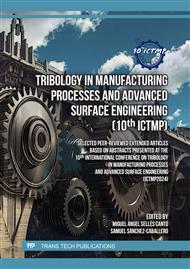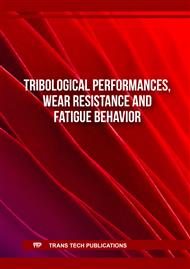[1]
X. Liang, Y. Xing, L. Li, W. Yuan, G. Wang. An experimental study on the relation between friction force and real contact area. Scientific Reports. 2021;11(1):20366.
DOI: 10.1038/s41598-021-99909-2
Google Scholar
[2]
K. Lee, C. Moon, M.G. Lee. A Review on Friction and Lubrication in Automotive Metal Forming: Experiment and Modeling. International Journal of Automotive Technology. 2021;22(6):1743-61.
DOI: 10.1007/s12239-021-0150-z
Google Scholar
[3]
C. Wichern, B. De Cooman, C. Van Tyne. Surface roughness changes on a hot-dipped galvanized sheet steel during deformation at low strain levels. Acta materialia. 2004;52(5):1211-22.
DOI: 10.1016/j.actamat.2003.11.005
Google Scholar
[4]
C.V. Nielsen, P.A. Martins, N. Bay. Modelling of real area of contact between tool and workpiece in metal forming processes including the influence of subsurface deformation. CIRP Annals. 2016;65(1):261-4.
DOI: 10.1016/j.cirp.2016.04.126
Google Scholar
[5]
H. Ike, A. Makinouchi. Effect of lateral tension and compression on plane strain flattening processes of surface asperities lying over a plastically deformable bulk. Wear. 1990; 140(1): 17-38.
DOI: 10.1016/0043-1648(90)90119-u
Google Scholar
[6]
M.P.F. Sutcliffe. Surface asperity deformation in metal forming processes. International Journal of Mechanical Sciences. 1988;30(11):847-68.
DOI: 10.1016/0020-7403(88)90010-0
Google Scholar
[7]
W.R.D. Wilson, S. Sheu. Real area of contact and boundary friction in metal forming. International Journal of Mechanical Sciences. 1988;30(7):475-89.
DOI: 10.1016/0020-7403(88)90002-1
Google Scholar
[8]
D. Korzekwa, P. Dawson, W. Wilson. Surface asperity deformation during sheet forming. International journal of mechanical sciences. 1992;34(7):521-39.
DOI: 10.1016/0020-7403(92)90028-f
Google Scholar
[9]
J.D. Westeneng. Modelling of contact and friction in deep drawing processes [Ph.D. dissertation]. University of Twente: Enschede; 2001.
Google Scholar
[10]
Z.G. Wang, Y. Yoshikawa, T. Suzuki, K. Osakada. Determination of friction law in dry metal forming with DLC coated tool. CIRP Annals. 2014;63(1):277-80.
DOI: 10.1016/j.cirp.2014.03.050
Google Scholar
[11]
M.F.R. Zwicker, J. Spangenberg, N. Bay, P.A.F. Martins, C.V. Nielsen. The influence of strain hardening and surface flank angles on asperity flattening under subsurface deformation at low normal pressures. Tribology International. 2022;167:107416.
DOI: 10.1016/j.triboint.2021.107416
Google Scholar
[12]
M.F.R. Zwicker, N. Bay, C.V. Nielsen. A new test for sheet metal asperity flattening under varying subsurface strain conditions. Tribology International. 2023;180:108249.
DOI: 10.1016/j.triboint.2023.108249
Google Scholar
[13]
M. Shisode, J. Hazrati, T. Mishra, M. de Rooij, T. van den Boogaard. Evolution of real area of contact due to combined normal load and sub-surface straining in sheet metal. Friction. 2021;9(4):840-55.
DOI: 10.1007/s40544-020-0444-6
Google Scholar
[14]
Standard test methods for tension testing of metallic materials ASTM E8/E8M. American society for testing and material; 2013.
Google Scholar
[15]
M.P. Shisode, J. Hazrati, T. Mishra, M.B. de Rooij, A.H. van den Boogaard. Semi-analytical contact model to determine the flattening behavior of coated sheets under normal load. Tribology International. 2020;146:106182.
DOI: 10.1016/j.triboint.2020.106182
Google Scholar



